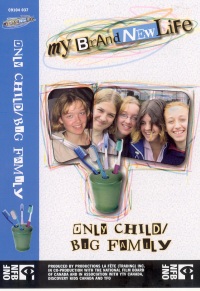| ________________
CM . . .
. Volume XI Number 20 . . . . June 10, 2005
This series features children who switch places to experience a different lifestyle in a different city. The premise of the series, trading lives with another person, is an intriguing concept for most children in this age range and is an interesting way to get kids to think about different ways of life. More like a reality tv series than a documentary, this format is bound to appeal to its audience. In this episode Anna, who lives in St. John's, NL, and has four siblings, and Allanah, who lives with her mother in Montreal, switch places. Anna is going to experience what it is like to be an only child, and Allanah is going to see what it is like to share everything with four brothers and sisters. Both girls are filmed in their new environment, and both have similar experiences, such as attending each others' school, going grocery shopping, and hanging out with the other girl's friends and family. They each keep a video diary where they record their thoughts and feelings in private. The video diaries are meant to show the girls' feelings more than the "official" footage but don't really accomplish this. Both girls are nervous at the beginning of the episode. Allanah fears that she won't like Anna's siblings, and Anna fears that she will be lonely on her own at night. It is very telling that, when Anna arrives in Montreal, she says right away that it would be more fun if her sisters were with her. Allanah is a bit overwhelmed by the family but quickly finds her place and makes good friends with Anna's sisters Karen and Sofie with whom she shares a room. The contrast between the two girls' experiences is shown very clearly. Both learn a lot in the short time they are away from home. Anna's loneliness is very apparent, and she really doesn't seem to know what to do with the time she has to herself. Allanah enjoys family game night and is a bit overwhelmed by the amount of food that is ordered in for the family dinner on their regular "order in" night. In contrast, Anna gets taken to a restaurant and is astonished that she is sitting at a table for two at a family dinner. During the viewing of Anna and Allanah's exchange, there are three breaks where the viewer gets the perspectives of other children on what would be the pros of being an only child, the pros of having siblings, and ideas of what the 'best" family would consist of. These excerpts break up the story and don't really add much information. The actions and emotions of the girls who have exchanged places are far more interesting and more in line with the reality tv format of the program. Only Child/Big Family may make children think more about what they would lose as well as what they would gain if they were to live a different life than the one they have and perhaps appreciate their own siblings or lack of siblings more. It may also give them some information about different choices and different ways to live which may be very different from their own. On the whole, it is a thought-provoking film shot in a format that children will find engaging. Recommended. Lisa O'Hara is a mother of three and a librarian in Winnipeg, MB.
To comment
on this title or this review, send mail to cm@umanitoba.ca.
Copyright © the Manitoba Library Association. Reproduction for personal
use is permitted only if this copyright notice is maintained. Any
other reproduction is prohibited without permission.
NEXT REVIEW
|TABLE OF CONTENTS FOR THIS ISSUE
- June 10, 2005.
AUTHORS
| TITLES | MEDIA REVIEWS
| PROFILES
| BACK ISSUES
| SEARCH | CMARCHIVE
| HOME |
